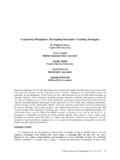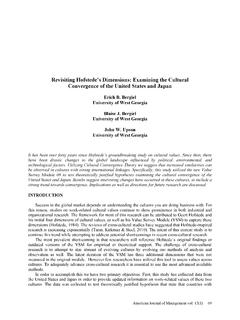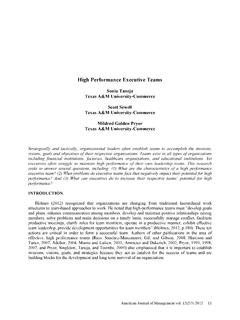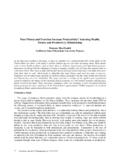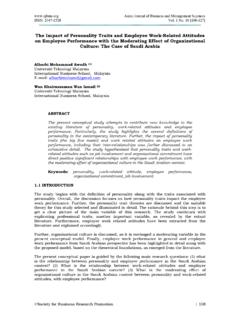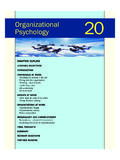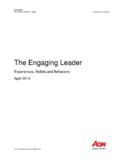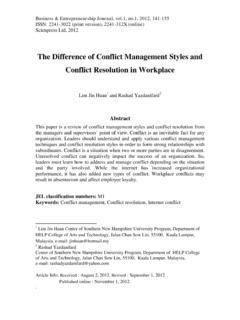Transcription of Myers-Briggs Type Indicator, A/B Personality Types, and ...
1 Myers-Briggs Type indicator , A/B Personality types , and Locus of Control: Where Do They Intersect? Cherie E. Fretwell Troy University Carmen C. Lewis Troy University Maureen Hannay Troy University Organizational researchers continually strive to establish models and patterns to predict the behavior of employees within the organizational context. However, much of this research relating to Personality types has been conducted in silos. Therefore, the goal of this paper is to explore the relationships among Myers-Briggs Type indicator , A/B Personality types , and Locus of Control. Data were collected via survey from 276 business students. INTRODUCTION Organizational researchers continually strive to establish models and patterns to predict the behavior of employees within the organizational context. Human behavior is inherently unpredictable; but by understanding the interactions among tasks, organization structure, the external environment, and individual Personality traits, we may, to some extent, be able to calculate the actions of individuals.
2 As a result, there has been an increased interest among researchers in understanding the role of Personality types in different work situations, particularly as it relates to predicting the type of Personality that will be most effective in different organizational environments (Spector & O'Connell, 1994; Tan & Tiong, 1999). There are many different aspects of Personality that can be evaluated and many different assessments tools that can be used to classify different aspects of individuals personalities. In this research we examine three different measures of Personality traits including the Myers-Briggs Type indicator , the Type A behavior pattern, and an individual s locus of control, in an effort to determine where these three indicators intersect. By establishing relationships among these variables, organizations may be better prepared to understand and predict employee behavior and thus design work environments, jobs and rewards that will maximize employee productivity, efficiency and satisfaction.
3 The rest of the paper is presented as follows: First, the theoretical framework that guides our study is described. A review of the Myers-Briggs Type indicator , A/B Personality types , and Locus of Control follows, and then a set of hypotheses is developed predicting the relationships between the constructs. A American Journal of Management vol. 13(3) 2013 57 research methodology and construct measures to test the hypotheses are presented, followed by the results from our analyses. The paper concludes with limitations and opportunities for future research. THEORETICAL DEVELOPMENT In this section, the Myers-Briggs Type indicator , the Type A behavior pattern, and locus of control literatures are reviewed and explored for potential relationships among the three constructs. In addition, our research hypotheses are presented.
4 Myers-Briggs Type indicator (MBTI) The Myers-Briggs Type indicator (MBTI) is one of the most widely used and recognized Personality preference instruments (Filbeck, Hatfield, & Horvath, 2005). The MBTI is essentially a Personality typology using four pairs of contrasting traits to create 16 Personality patterns (Abrams, 2011). It was developed by Isabel Briggs Myers and her mother, Katharine Cooks Briggs, who integrated their own concepts and research with the theory of Personality developed by psychiatrist Carl Jung (Abrams, 2011). Its popularity persists because it focuses on normal as opposed to pathological behavior and its logic and descriptions are straightforward and nonthreatening (Fox-Hines & Bowersock, 1995; Zemke, 1992). The MBTI provides a framework for examining similarities and differences in Personality traits by assessing an individual s preferences regarding perceptions and judgments (Opt & Loffredo, 2003; Tan & Tiong, 1999).
5 The MBTI utilizes self-reporting to determine an individual s dominant preferences on four opposing dimensions: extroversion-introversion (E-I), sensation-intuition (S-N), thinking-feeling (T-F), and judgment-perception (J-P). As a result of the interactions among these preferences, 16 distinctive Personality types are identified by the instrument. The MBTI score also indicates the strength of the preference for each dimension. Stronger scores indicate a greater likelihood that the individual has developed the attributes associated with those preferences (Tan & Tiong, 1999; Varvel, Adams, Pridie, & Ruiz Ulloa, 2004). Extraversion-Introversion The E-I index reflects where individuals prefer to focus their attention. Extraverts are oriented primarily to the outer world of experience including people and things, while introverts are oriented more towards the inner world of experience including concepts and ideas.
6 Extroverts get their energy from the outside world of people while for introverts energy comes from the inside world of thoughts and ideas. Extroverts are people and action-oriented, like variety and action, and they can act quickly (sometimes without thinking). They prefer oral communication and can communicate freely with others. They work quickly and dislike complicated procedures, but they can be impatient at long slow jobs. Introverts are more contemplative, like quiet concentration, are careful with details and enjoy working on one project for a long time. They are content to work alone and prefer to utilize written communication (Filbeck et al., 2005; Fox-Hines & Bowersock, 1995; McPherson, 1999; Myers & McCaulley, 1989; Opt & Loffredo, 2003; Tan & Tiong, 1999; Varvel et al.)
7 , 2004). Sensing-Intuition The S-N Index reflects how individuals acquire information about their surroundings and how they choose to perceive the world. Those with a sensing preference prefer concrete details of a situation and rely on the five senses to observe facts or happenings. An intuitive prefers to look at the overall picture of an experience, relying on a sixth sense or personal hunches or insight rather than on the five senses. They enjoy novelty, change and the unusual. Sensing types tend to be more realistic and practical while intuitive types focus on the future and the possibilities that it holds (Filbeck et al., 2005; Fox-Hines & Bowersock, 1995; McPherson, 1999; Myers & McCaulley, 1989; Opt & Loffredo, 2003; Tan & Tiong, 1999; Varvel et al., 2004). 58 American Journal of Management vol.
8 13(3) 2013 Thinking-Feeling The T-F index reflects the preferences of individuals for making decisions, processing data, and evaluating their perceptions. Those with a thinking preference use logic, facts, and fairness. They strive for objectivity and the application of principles to a decision. They are often uncomfortable dealing with the feelings of others. Those with a feeling preference use personal or social values when making decisions. Their decisions are more subjective in nature, and they consider the impact that their decisions will have on others. They enjoy pleasing others and are more likely to offer appreciation and sympathy (Filbeck et al., 2005; Fox-Hines & Bowersock, 1995; McPherson, 1999; Myers & McCaulley, 1989; Opt & Loffredo, 2003; Tan & Tiong, 1999; Varvel et al., 2004). Judging-Perceiving The J-P index addresses how people prefer to organize and orient themselves to the outer world.
9 Individuals who utilize a judging preference (either thinking or feeling) focus on leading an organized and orderly life. They are punctual, orderly, seek closure, and prefer control over their lives through detailed planning. They are action-oriented, decisive, and may see things as black and white, which can manifest itself as a closed-minded attitude. Those with a perceiving preference (either sensing or intuition) are more spontaneous and open to new ideas. They are more flexible and relaxed; they go with the flow, and resent time constraints. They see more grays and tend to be more open-minded. These individuals prefer to adapt to situations rather than control them (Filbeck et al., 2005; Fox-Hines & Bowersock, 1995; McPherson, 1999; Myers & McCaulley, 1989; Varvel et al., 2004). Using data provided by Filbeck et al. (2005) and Fox-Hines and Bowersock (1995), Table 1 provides an approximate distribution of each dimension in the general population.
10 The Myers & Briggs Foundation at i ndicates the distribution in the population to be for Extroverts and for Introverts. TABLE 1 BREAKDOWN OF EACH DIMENSION IN THE POPULATION Preference for Being in the World Extroverted (E) 70-75% Introverted (I) 25-30% Preference for Gathering Data Sensing (S) 70-75% Intuitive (N) 35-30% Preference for Making Decisions Thinking (T) 60% males, 40% females Feeling (F) 60% females, 40% males Preference for Either Making Decisions or Gathering Data Judging (J) 55% Perceiving (P) 45% According to Fox-Hines and Bowersock (1995), there are more Extroverted, Sensing, Judging types in the than those who are classified as Introverted, Intuiting or Perceiving. The Thinking-Feeling index is the only dimension that persistently demonstrates differences along gender lines with more males being classified as Thinking and more females as Feeling.

